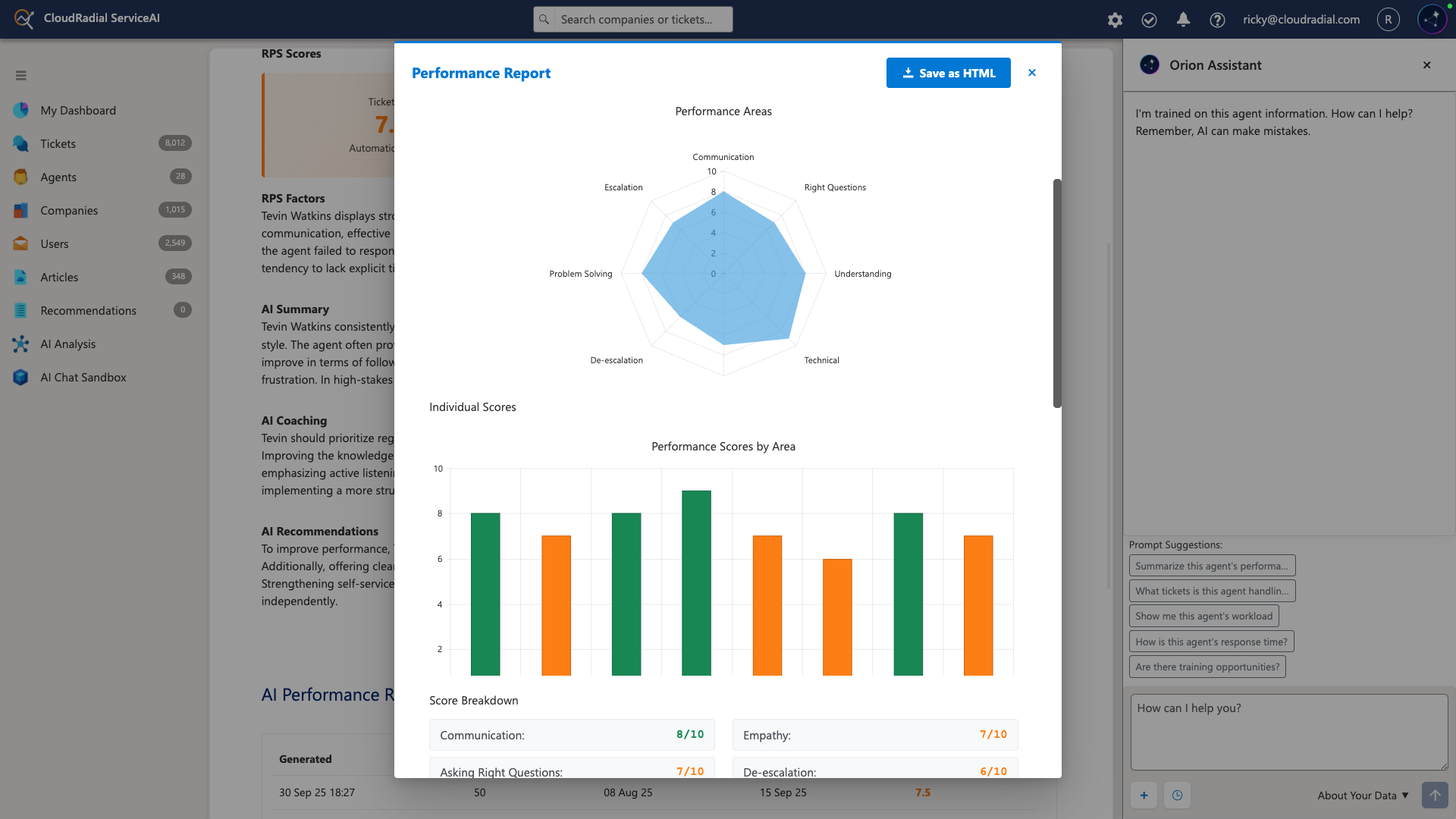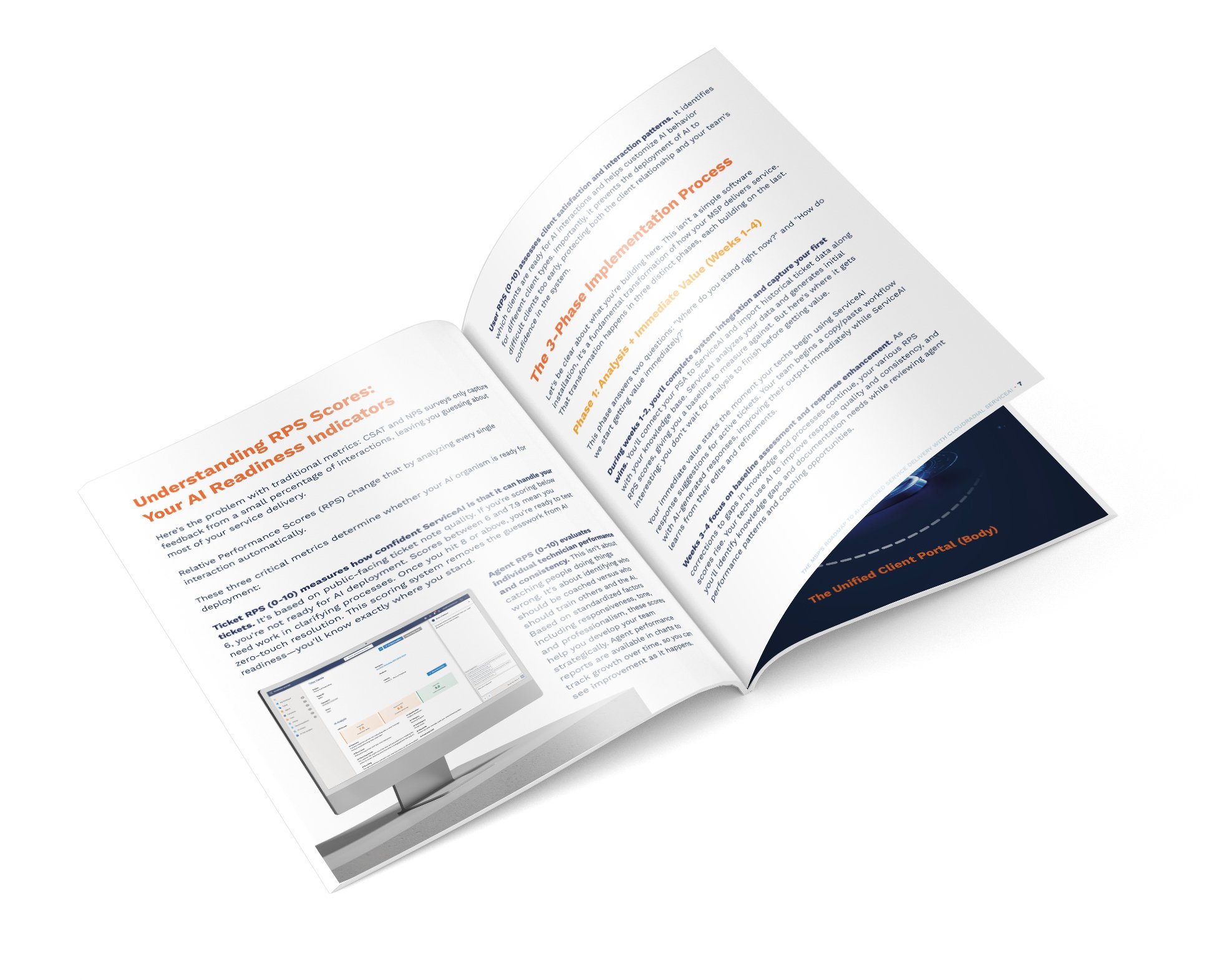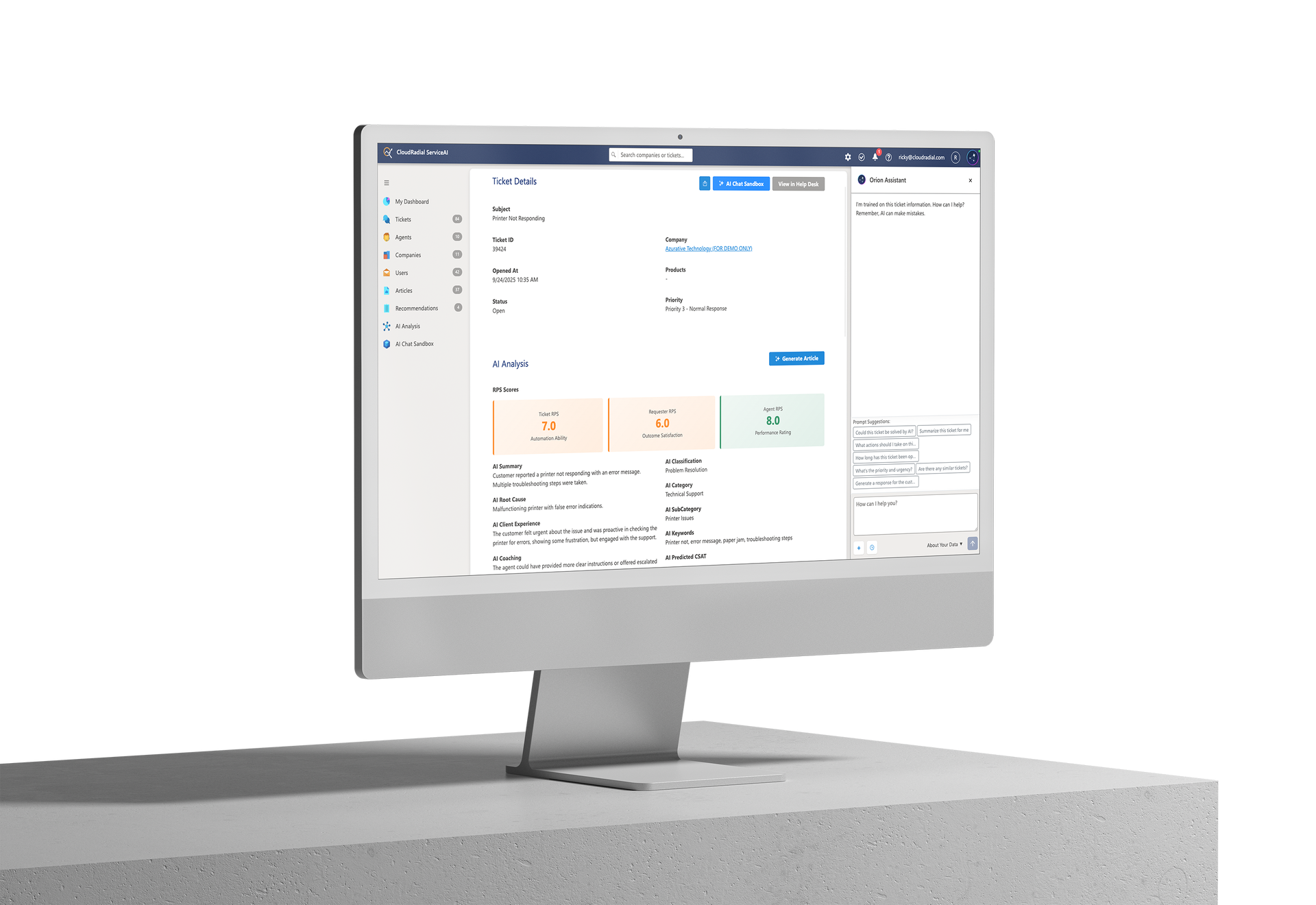Stop Measuring Productivity: Why AI Transformation Requires Different Metrics
Your service desk manager pulls up the dashboard and smiles. Response times are down 35%. Tickets per technician are up 22%. Documentation time has...
Get everything you need for the ultimate client experience
Enterprise-grade infrastructure with the flexibility MSPs demand
Perfectly tailored AI that knows your specific MSP

Build your own Shopify-like store with your PSA products & distributors
Have clients to submit tickets directly to your PSA, freeing up your team's time
Pre-triage and route tickets correctly with the help of AI
Deliver instant, accurate answers that can help achieve zero-touch resolution
You'll learn things like how to add revenue without adding cost, MSP best practices, and how to master client management.

It needs a tool that can streamline and automate your QBRs so you can focus on providing a better client experience and growing your business. There’s no excuse for a bad client experience, and CloudRadial turns a much maligned pain point into an effective tool.
Thinking back to when Autotask and ConnectWise first shipped, dial-up connections were the norm and internet speeds were too slow to handle things like embedded images. HTML email didn’t become a standard for years.
As the Internet matured, more and more Internet-based services sprouted up. Businesses like Amazon started to redefine how customer relationships could happen on the web. Sadly, the MSP industry has struggled to eliminate the barrier between provider and customer in the way Amazon has.
The key benefits of a customer relationship like that between Amazon and it’s shoppers are:
And all of these great features are accessible from one centralized customer portal.
When you really start to look at the industry-standard PSAs like ConnectWise and Autotask next to the way Amazon handles customer relations, it’s apparent that something is missing.
Clients have come to expect a seamless, centralized experience where they can access everything they need. Patience is running thin for an outdated model and CloudRadial provides the customer-facing experience now expected.
There are three basic things that clients expect out of a relationship with a service provider.
How do you know if a client portal is good? If your clients use it and use it regularly. When your client portal becomes more than a link that is attached to every ticket or support webpage. A client portal is good when your clients know how to use it and can rely on it to give them what they need. Salesforce even found that a portal that empowers client self-service increases loyalty.
After enough time spent noticing how many MSP clients struggle with client portals, CloudRadial decided to create a robust and customizable solution to the client portal problem. With CloudRadial, anything you or your clients need to access regarding services can be programmed into the platform.
This means your client has transparency, reporting, insights and can see things like active services, open tickets, scheduled updates, as well as a catalog of your services that they can add.
For the MSP, CloudRadial automated the tedium of your client relationships. Less manual emails regarding ticket status. A clear, organized IT portal that shows what services you deliver to what clients. Simple upsell opportunities. Complete oversight of services and platforms.
All of it delivered in a simple to set up, simple to understand centralized hub.
With all of this at your fingertips, CloudRadial provides you with the time to become the strategic partner your clients want.
Quarterly business reviews are an industry-standard practice. But should they be?
Think about it – does Netflix give you a QBR? Your Internet provider? How about your bank, your electric company or your landscaper?
These large, commonplace industries that offer services to huge swaths of people don’t provide more than a monthly bill. So why are MSPs stuck wasting hours every quarter gathering information for one client’s QBR?
At its core, a QBR tries to accomplish three very simple tasks:
MSPs lean on QBRs because much of what you provide is behind-the-scenes service. Clients don’t see all the things that go right, yet they are acutely aware when something goes wrong. You know your electric company is supplying service because your lights are on. You know Netflix is providing service because you just spent 3 hours binge-watching the latest season of Stranger Things.
With CloudRadial, you can simultaneously make your QBRs more effective and less time-intensive to put together. This is done through the client IT portal and the magic of automation.
In CloudRadial, you are able to set up exactly what the client sees in their portal. That means every time your clients first load up the portal, they can see what services you are providing, open tickets, average ticket close time, any updates coming or even services that they might want to consider adding. Essentially, every time your clients visit their portal in CloudRadial, they are getting a full business report that is always up-to-date.
When your QBRs become DBRs (daily business reports) that are automated, that frees up your valuable time.
We’re not saying QBRs are a waste of time. But why waste time on them if you don’t need to?
Ticketing is a hassle for clients. Not only does a ticket mean something is wrong, but there is also the process of submitting a ticket and the ensuing back and forth as you try to correctly identify the problem. Often, there is plenty of wasted time baked into the ticketing process.
Your ticketing should aim to be more like Amazon’s return process. The client answers a set of simple, predefined questions and clicks submit. In the MSPs case, those questions should be simple enough for any client to understand while also providing you with the information you need to escalate the ticket properly.
By building your ticketing system into CloudRadial, your clients can do just that. You set your predefined questionnaire, an approval routing process if needed, and your clients can access it all through their portal. Less time spent manually identifying and categorizing issues and more time spent solving problems.
Your clients know what services you are currently providing, but do they know the whole stack of services you have available?
Being able to identify revenue opportunities with current clients is one of the lowest effort returns you can seek as a business. That’s where your service catalog comes in.
Most MSPs know their service catalog. Rarely is that information shared with clients in its entirety. Instead, MSPs only become aware of an upsell opportunity when a client comes to them looking for the solution. With CloudRadial, that critical error is eliminated.
Within the client portal, you are able to share your complete service offering with clients. This turns your service catalog into an online marketplace where clients can browse and purchase solutions. It also enables you to educate and recommend solutions they might be missing.
Really, there is a lot of revenue to be made if your clients can easily shop for your services.
Keeping your staff and clients on the same page is a challenge that, let’s face it, we often fall short of. Not only is it a lot of information, but it’s information that needs to be dissimilated differently to different people. Your service team wants to know all of the information they can, where your clients may only care about open and closed ticket counts. This means that much of the communication between you and your clients needs to be handled somewhat manually.
And manual communications are prone to errors like unsent messages, slow response times or unintended recipients. The opportunity for human error with constant communication is a very real struggle.
CloudRadial tackles this problem by building in a whole suite of easy communication tools. Within the portal you can:
By keeping all your communications within CloudRadial and automating the more mundane updates, you eliminate errors and can more easily keep clients abreast of what is happening.
Every MSP’s goal is to go beyond simple ongoing support. Being of strategic value is the way you become a true partner to your clients. Of course, there are barriers that make it hard to earn that level of trust. The first and most persistent hurdle is showing your clients the value of what you currently supply.
You can’t be a strategic partner without the trust of a client. And earning that trust is all about showing them that you are doing what you promised. And again, we have the QBR rearing its head.
But as we’ve established, CloudRadial shuffles off QBRs to the client portal so that every day your customers see what you’re doing for them. That means you are constantly building trust between you and the customer as well as gaining time to actually fill that lauded vCIO role.
You can spend less time showing your clients that, yes, you’ve been delivering the promised services and spend more time presenting them with improvements that can help their business function better. When you are able to talk about growth and efficiency instead of just management, your clients will begin to trust you to fill the vCIO role they need.
What does that look like from your end, though? Well, think about the general hierarchy of function that a law firm has:
Level 1: Vendor contracts
Level 2: Business agreements
Level 3: Litigation
Level 4: Mergers and acquisitions
Level 5: Strategy
Sure, it’s a ladder you’ll need to climb. But CloudRadial handles the first few steps so you can be a strategic partner for all of your clients.
Your client relationships are important, but let’s face it, there is a lot of time wasted on the mundane minutiae. With CloudRadial, automation and control empower you to take your client relationship beyond service delivery. It’s time to become the partner that gives them the power and strategy to take their business to the next level. It’s time to change what you can do with your client portal.

Your service desk manager pulls up the dashboard and smiles. Response times are down 35%. Tickets per technician are up 22%. Documentation time has...

Most AI implementations fail because they're treated like software installations instead of business transformations.

Picture this: you send out CSAT surveys after tickets close, and maybe you track NPS quarterly. You get back responses from 15-20% of your clients....